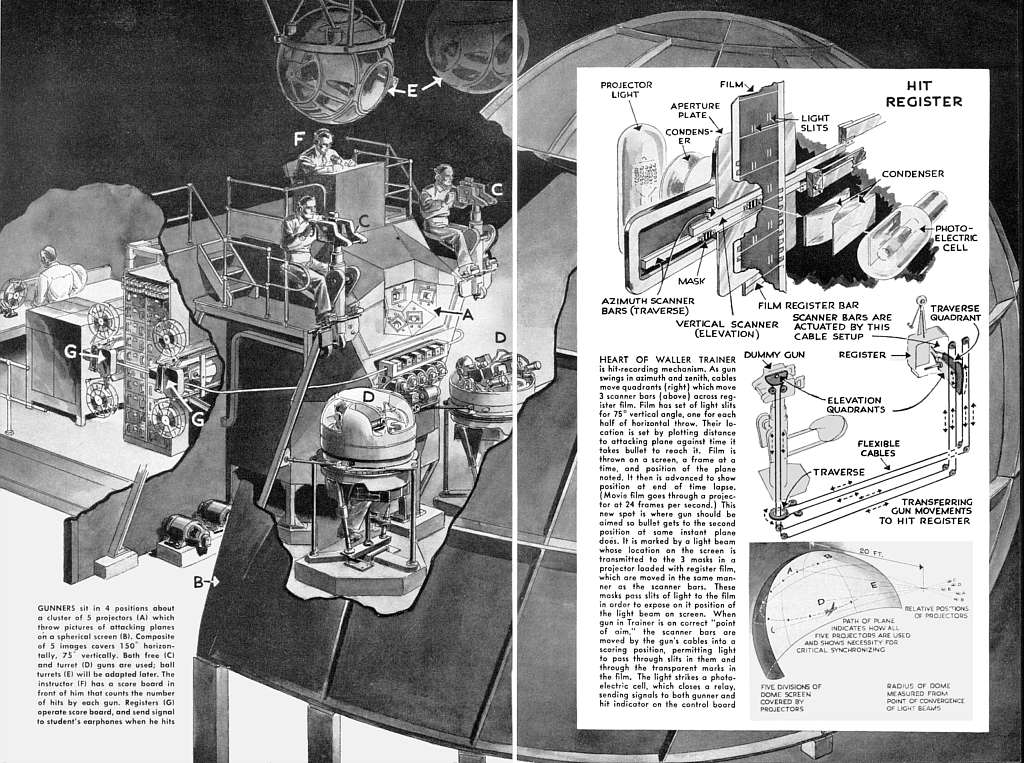While I was working for a
post on the Vintage Aviation Books and Periodicals thread, I came across a number of publications with information relating to this thread.
One is a mention of a
Manual for Instruction on Poorman Flexible Gunnery Trainer, Air Forces Manual 66.
[1] Other than a single picture in an issue of
Bomber Legends magazine, I initially couldn't find any further reference to the device.
[2] However, further searches lead me to a device called the "Waller Gunnery Trainer".
[3][4] It apparently featured a spherical screen onto which images of airplanes were projected:

(Source:
American WideScreen Museum)
A little bit later, I discovered the answer. A man named Fred S. Poorman filed for a patent of an
Aircraft Gunnery Practice Range, 2,457,832, in 1945. (To confuse matters, the description of a Periscope Film video states the "poorman" was a "'poor man's' version of a Waller Trainer".
[5] However, this appears to be either a false or coincidental etymology. This is supported by the fact that references to the trainer refer to it with the single word "poorman", rather than as the two word "poor man".)
Attachment:
 2,457,832 – Aircraft Gunnery Practice Range.png [ 98.3 KiB | Viewed 1963 times ]
2,457,832 – Aircraft Gunnery Practice Range.png [ 98.3 KiB | Viewed 1963 times ]
(Source:
United States Patent and Trademark Office)
Another manual describes "six specific synthetic aids" used in gunnery training:
Fixed Aerial Gunnery: How to Make Your Bullets Hit wrote:
1. Recognition, range and point-of-aim cards
2. The stationary deflection trainer
3. The range estimator
4. Dual Projection Trainer
5. Link BB Range
6. The Gunairstructor
(Source:
Library of Congress)
Finally, the November 1944 issue of
Air Force magazine describes a "Dead Reckoning Navigation Trainer, Type G-2" that I was not aware of before.
[6] Some quick searching lead me to a series of AirCorps Library manuals that revealed that the USAAF employed a number of such trainers designated the G-1, G-1A, G-2, and G-3. This, in turn, resulted in the realization that the initial letter of each trainer's designation appears to have indicating the role. With that knowledge - and some references - the sequence can be partially pieced back together:
- Type A-2 Bombing Trainer[7]
- Type A-2A Bombing Trainer[7]
- Type A-2B Bombing Trainer[7]
- Type A-6 Bomb Trainer[8]
- Type C-2 Instrument Flying Trainer[9]
- Type C-3 Instrument Flying Trainer[9]
- Type C-4 Instrument Flying Trainer[9]
- Type C-5 Instrument Flying Trainer[9]
- Type C-8 Trainer[10]
- Type C-11A Jet Propelled Aircraft Instrument Flying Trainer[10]
- Type D Instrument Flying Trainer[11]
- Type D-1 Instrument Flying Trainer[11]
- Type D-2 Instrument Flying Trainer[11]
- Type E-5 Aerial Gunnery Trainer[12]
- Type E-9 Aerial Gunnery Trainer[12]
- Type E-10 Aerial Gunnery Trainer[13]
- Type E-11 Aerial Gunnery Trainer[14]
- Type E-12 Fixed Gunnery Trainer[15]
- Type E-21 Mirror Range Estimation Trainer[16]
- Type E-22 Mirror Range Estimation Trainer[16]
- Type F-1 Torpedo Launching Trainer[17]
- Type G-1 Navigation Dead Reckoning Trainer[18]
- Type G-1A Navigation Dead Reckoning Trainer[18]
- Type G-2 Dead Reckoning Navigation Trainer[19]
- Type G-3 Navigation Dead Reckoning Trainer[20]
- Type Z-1 0-250 Knots Instrument Flying Trainer[10]
- Type Z-2[21]
- Type Z-3[21]
- Type Z-4[21]
As best as I can tell, the D model was only used by the British Commonwealth and never by the USAAF. However, the designation was likely nevertheless reserved to avoid confusion.
The Type E-12 is the "BB range" referred to in the document from the Library of Congress above:
Attachment:
 Type E-12 Fixed Gunnery Trainer.png [ 553.1 KiB | Viewed 1963 times ]
Type E-12 Fixed Gunnery Trainer.png [ 553.1 KiB | Viewed 1963 times ]
(Source:
AirCorps Library)
The Type G-1 is apparently the "Navitrainer" mentioned in a
previous post:
Attachment:
 Type G-1 Navigation Dead Reckoning Trainer.png [ 852.08 KiB | Viewed 1963 times ]
Type G-1 Navigation Dead Reckoning Trainer.png [ 852.08 KiB | Viewed 1963 times ]
(Source:
AirCorps Library)
The Type G-2 was actually made up of a total of 40 booths linked together:
Attachment:
 Type G-2 Dead Reckoning Navigation Trainer.png [ 733.68 KiB | Viewed 1963 times ]
Type G-2 Dead Reckoning Navigation Trainer.png [ 733.68 KiB | Viewed 1963 times ]
(Source:
AirCorps Library)
Finally, I learned, thanks to another
WIX thread, that some B-24s had B-29 turrets installed and were used as gunnery trainers, such as this B-24H, 42-95065:

(Source:
Warbird Information Exchange)
EDIT (24-04-04): Another version of reference #3
available via archive from another website includes more pictures and better formatting.





